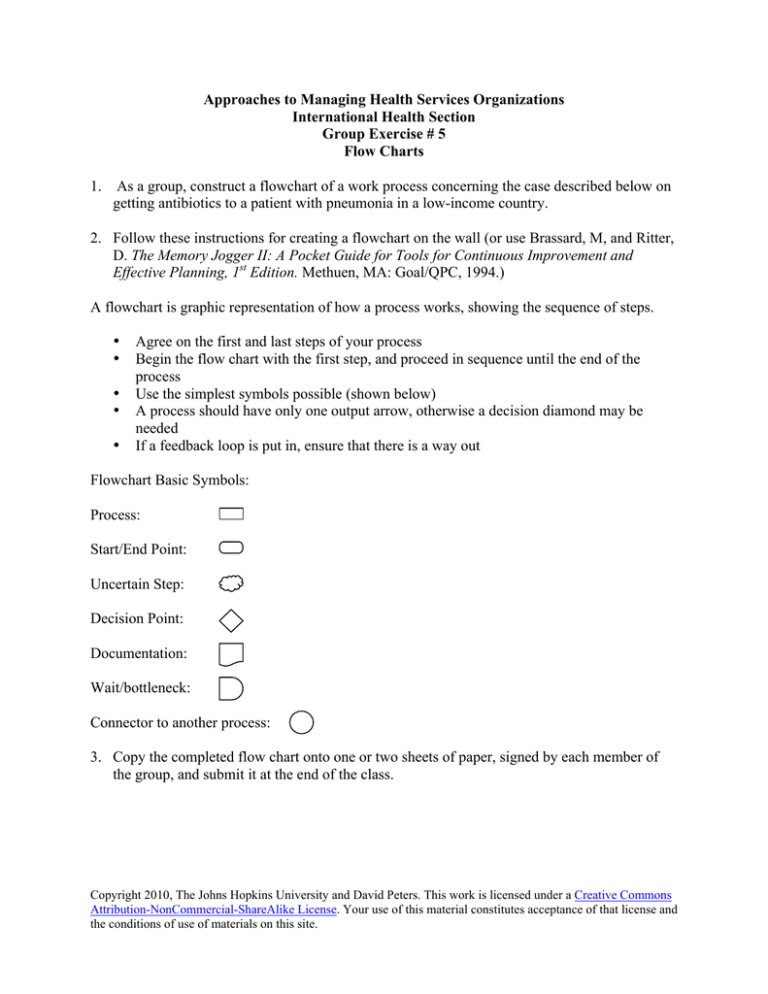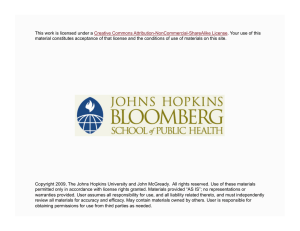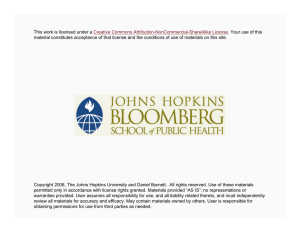Approaches to Managing Health Services Organizations International Health Section Flow Charts
advertisement

Approaches to Managing Health Services Organizations International Health Section Group Exercise # 5 Flow Charts 1. As a group, construct a flowchart of a work process concerning the case described below on getting antibiotics to a patient with pneumonia in a low-income country. 2. Follow these instructions for creating a flowchart on the wall (or use Brassard, M, and Ritter, D. The Memory Jogger II: A Pocket Guide for Tools for Continuous Improvement and Effective Planning, 1st Edition. Methuen, MA: Goal/QPC, 1994.) A flowchart is graphic representation of how a process works, showing the sequence of steps. • • • • • Agree on the first and last steps of your process Begin the flow chart with the first step, and proceed in sequence until the end of the process Use the simplest symbols possible (shown below) A process should have only one output arrow, otherwise a decision diamond may be needed If a feedback loop is put in, ensure that there is a way out Flowchart Basic Symbols: Process: Start/End Point: Uncertain Step: Decision Point: Documentation: Wait/bottleneck: Connector to another process: 3. Copy the completed flow chart onto one or two sheets of paper, signed by each member of the group, and submit it at the end of the class. Copyright 2010, The Johns Hopkins University and David Peters. This work is licensed under a Creative Commons Attribution-NonCommercial-ShareAlike License. Your use of this material constitutes acceptance of that license and the conditions of use of materials on this site. Case: Getting antibiotics to the patient who needs it in a low-income country Pneumonia is one of the most common causes of death in children in the world. Ensuring that appropriate antibiotics are available for the child seeing a health worker is one of the most important tasks of the health system. The widespread problem of frequent unavailability of antibiotics at primary care centers decreases the effectiveness, acceptability, use and morale of government clinics in many developing countries. The process of ensuring antibiotic (or any product) availability requires appropriate action at several levels in any health care system, as illustrated by The Logistics Cycle (See “The Drug Supply Process and its Pitfalls” below). As the deputy provincial medical officer in a low-income country, you are responsible for public sector pharmaceutical supplies in the province. You think you now have an adequate drug budget, but clinics still report that they run short of antibiotics. To understand why you still have this problem, you want to outline the process for how drugs reach the patients. With your team, prepare a flowchart that shows your actual supply process, and then indicate where the problems are and what actions might be taken to ensure that the appropriate antibiotics are made available to the patient with pneumonia. Use the individual experiences in your group, and ensure that you address the main phases of The Logistics Cycle shown below. Copyright 2010, The Johns Hopkins University and David Peters. This work is licensed under a Creative Commons Attribution-NonCommercial-ShareAlike License. Your use of this material constitutes acceptance of that license and the conditions of use of materials on this site. The Drug Supply Process and its Pitfalls Logistics is the science of procuring, maintaining, and transporting supplies. It involves delivering large amounts of supplies on schedule to many people at service delivery points located in numerous different places. Alternatively, logistics is also called Supply Chain Management. Succinctly, the purpose of a logistics system is to assure the “six rights”; to get the Right quantities of the Right goods to the Right places at the Right time in the Right condition at the Right cost for all the customers In drug supply, it includes all aspects of the process required to bring a drug from the supplier to the dispenser and, ultimately, to the individual patient. Logistics systems are truly “systems” in that they require the coordinated efforts of many individual units inside and outside the government. When the separate tasks are performed not as part of a system but independently and disjointedly, costs rise, shortages become commonplace, and patients suffer. The primary functions in the logistics cycle of any drug supply system fall into four categories (Figure 1): 1. Drug Selection includes issues such as what products should be available and in what quantities. 2. Procurement includes purchasing methods, finance, terms of payment, sources of supply, contracts, quality assurance, and decisions to make or buy a product. 3. Distribution includes import management, storage, inventory control, ordering, dispatching, waste management, and transport. 4. Use includes prescribing and dispensing practices, packaging and labeling, training auxiliary personnel, and educating consumers. Just as the basic functions of a logistics system are similar from country to country, the pitfalls encountered in supplying drugs are surprisingly similar from place to place. 1. Selection is often inefficient, especially where pharmaceutical knowledge is lacking, information on current therapeutics is unavailable, or the process for selecting drugs is disjointed or haphazard. The results can be: Purchase of too many products – an unnecessarily large variety of items may duplicate each other, consume limited inventory capital, and complicate distribution. Essential Drug Lists help avoid this. Copyright 2010, The Johns Hopkins University and David Peters. This work is licensed under a Creative Commons Attribution-NonCommercial-ShareAlike License. Your use of this material constitutes acceptance of that license and the conditions of use of materials on this site. Purchase of unnecessarily expensive products – there are frequently cheaper, equally effective alternatives available, e.g. generics. Purchase of inappropriate products – limited funds are expended on new drugs whose clinical efficacy has not been established, on unproven combination products, and on symptom-relief preparations when there are insufficient quantities of more essential drugs such as antibiotics and vaccines 2. Procurement refers to obtaining pharmaceuticals, not only through purchase, but also through donations and government production. Problems are frequent with regard to: Purchase of inappropriate quantities – requirements may be overestimated for some items and underestimated for others due to faulty forecasting Supplier selection – unreliable suppliers withdraw or change their offers during the tender process, deliver substandard products or goods near their expiration dates, or fail to replace back batches Contract terms – supplier contracts do not provide adequate product specifications, set labeling and packaging requirements, establish firm price and currency exchange conditions, or provide a mechanism for holding suppliers accountable for their errors Quality assurance – inadequate attention is paid to drug quality prior to purchase and on arrival of shipments; there is a lack of careful monitoring of port, warehouse, in-country transport, and peripheral storage conditions, expiration dates, and rotation of stock Make or buy options – production possibilities are pursued in areas which are too technical, too expensive, or both, while feasible opportunities for limited local production go unrecognized Financing – procurement is limited by lack of funds, while the public, even in remote areas, buys drugs at high commercial prices 3. Distribution is a complex and highly varied function. In some programs commercial distribution networks are relied on for most deliveries, while in other programs the government assumes the entire responsibility for moving drugs from a central national warehouse all the way to the farthest health post and community health worker. Analysis of distribution networks often reveals difficulties with: Information mismanagement --- too much information is recorded, too little information is used, or the information obtained from consumption records, vital statistics, accounting records, and other information sources is misused Port-clearing – failure to obtain proper import documents or inexperience with the port-clearing process results in demurrage charges, increased losses from spoilage and theft, and unnecessary delays Storage – spoilage is hastened by overcrowded, disorganized warehouses and customs sheds, inadequate moisture, temperature, or pest controls, and Copyright 2010, The Johns Hopkins University and David Peters. This work is licensed under a Creative Commons Attribution-NonCommercial-ShareAlike License. Your use of this material constitutes acceptance of that license and the conditions of use of materials on this site. 4. regional distribution facilities even more poorly maintained; limited space is used sub-optimally; inadequate security leads to further losses from theft Transportation – disorganized public transport scheduling, poor maintenance, and failure to consider private sector systems slow delivery and increase costs Stock mismanagement – managers are frequently unaware of what supplies they have on hand or where they are; supplies needed in one region may gather dust in another, because their presence is unknown or because mechanisms for transferring stocks do not exist. Use of pharmaceuticals is influenced by factors both inside and outside the public health programs. The ability of the logistics system to meet public health needs is highly related to usage patterns. Common problems with the use of drugs include: Poor packaging and labeling – containers may be unsuitable for the environment, labels unreadable by the consumer, or packaging quantities inappropriate for dispensing or patient use Careless dispensing practices – dispensing is carried out under unsanitary conditions with dirty utensils; creams and liquids are dispensed into unwashed bottles; pills are simply wrapped in paper; patients often receive only oral instructions Irrational prescribing – lack of mechanisms to promote uniform prescribing habits results in rampant over- or under-use of drugs; use of ineffective drugs or un-indicated multiple prescriptions requires the supply system to procure, store, and deliver unnecessary items Patient use – there is noncompliance with treatment due to inadequate instruction, the quantity dispensed, or unrealistic dosage schedules. These are only a sampling of the many problems that exist to hinder the effective delivery of pharmaceuticals through primary health programs in many developing countries. Copyright 2010, The Johns Hopkins University and David Peters. This work is licensed under a Creative Commons Attribution-NonCommercial-ShareAlike License. Your use of this material constitutes acceptance of that license and the conditions of use of materials on this site. Figure 1: The Logistics Cycle Selection Use Management of: People Information Money Facilities Transport Procurement Forecasting Distribution Storage Inventory control Ordering/dispatching Adapted from Managing Drug Supply, Boston: Management Sciences for Health, 1981 Copyright 2010, The Johns Hopkins University and David Peters. This work is licensed under a Creative Commons Attribution-NonCommercial-ShareAlike License. Your use of this material constitutes acceptance of that license and the conditions of use of materials on this site.

